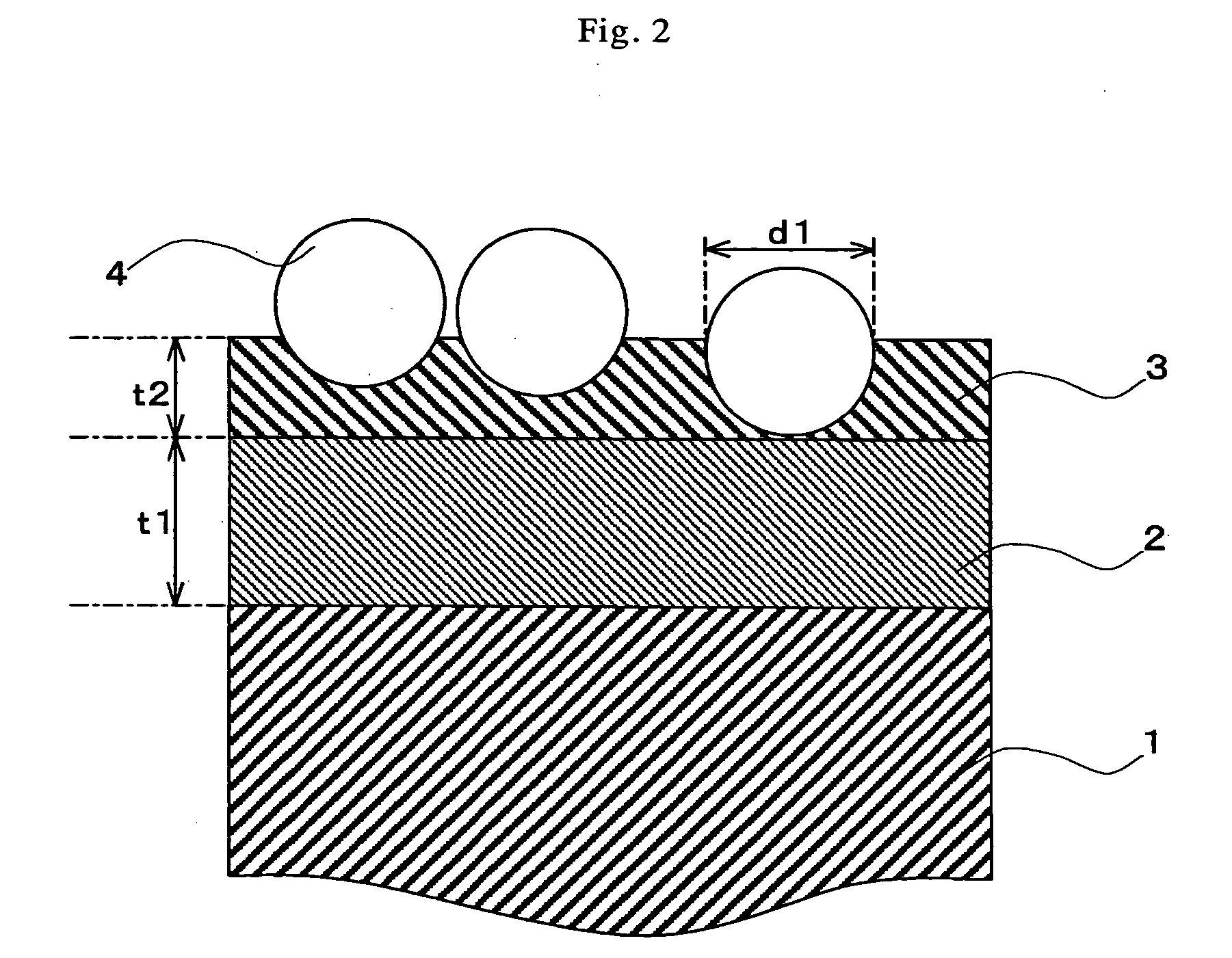Electrophotographic toner and manufacturing method thereof
- Summary
- Abstract
- Description
- Claims
- Application Information
AI Technical Summary
Benefits of technology
Problems solved by technology
Method used
Image
Examples
Example
Example 1 for Producing a Core Particle: Suspension Polymerization Method
[0064] After sufficiently dispersing a mixed solution of 80 parts by weight of styrene, 20 parts by weight of 2-ethylhexyl methacrylate, 5 parts by weight of carbon black, 3 parts by weight of low-molecular-weight polypropylene, 2 parts by weight of charge control agent (“BONTRON P-51” by Orient Chemical Industries, Ltd.) and 1 part by weight of divinylbenzene (cross-linking agent) with a ball mill, 2 parts by weight of 2,2-azobis (2,4-dimethyl valeronitrile) was added as a polymerization initiator. Then, 400 parts by weight of ion-exchanged water was added thereto. Furthermore, as suspension stabilizer, 5 parts by weight of tribasic calcium phosphate and 0.1 parts by weight of sodium dodecylbenzene sulphonate were added. After 20 minute agitation at a revolution speed of 7000 rpm with a TK Homo Mixer (by Tokushu Kika Kogyo), polymerization reaction was carried out at 70° C. and 100 rpm in nitrogen atmosphere f...
Example
Example 2 for Producing a Core Particle: Emulsion Polymerization and Aggregation Method
(1) Emulsion Polymerization of Binder
[0065] 20 parts by weight of styrene, 3.5 parts by weight of butyl acrylate, 0.2 parts by weight of divinylbenzene, 0.7 parts by weight of potassium persulfate as a water-soluble polymerization initiator and 200 parts by weight of ion-exchanged water were put into a round-bottom flask and underwent emulsion polymerization at 100 rpm and 70° C. for 8 hours with an anchor-type impeller, thereby obtaining a dispersion liquid (Dispersion liquid 2) containing styrene acrylic having a mean particle size of 0.3 μm.
(2) Preparation of Additive Dispersion Liquid
[0066] 5 parts by weight of Carnauba wax type 1 (by S. Kato & Co.), 2 parts by weight of BONTRON P-51 (by Orient Chemical Industries, Ltd.), 4 parts by weight of C.I. Pigment Red 122 (by Dainippon Ink and Chemicals Incorporated) and 0.1 parts by weight of sodium dodecylbenzene sulphonate were put into 200 par...
Example
Example 3 for Producing a Core Particle: Kneading Pulverization Method
[0068] 100 parts by weight of binder resin (“TUFTONE NE-410” by Kao Corporation), 5 parts by weight of carbon black (“MA-100” by Mitsubishi Kasei Corporation), 5 parts by weight of charge control agent (“BONTRON P-51” by Orient Chemical Industries, Ltd.) and 4 parts by weight of Carnauba wax type 1 (by S. Kato & Co.) were put into and mixed in a Henschel mixer, then melted and kneaded with a biaxial extrusion machine, cooled with a drum flaker, and coarsely ground with a hammer mill. Next, through pulverization by a mechanical mill and classification by an air classifier, a core particle having a volume average particle size of 8 μm was prepared. Subsequently, by adding 1.0 part by weight of surfactant (sodium dodecylbenzene sulphonate) and dispersing in 500 parts by weight of ion-exchanged water, a dispersion liquid of core particles (Dispersion liquid 5) was obtained. Tg of the core particle so obtained was 62° ...
PUM
 Login to View More
Login to View More Abstract
Description
Claims
Application Information
 Login to View More
Login to View More - R&D
- Intellectual Property
- Life Sciences
- Materials
- Tech Scout
- Unparalleled Data Quality
- Higher Quality Content
- 60% Fewer Hallucinations
Browse by: Latest US Patents, China's latest patents, Technical Efficacy Thesaurus, Application Domain, Technology Topic, Popular Technical Reports.
© 2025 PatSnap. All rights reserved.Legal|Privacy policy|Modern Slavery Act Transparency Statement|Sitemap|About US| Contact US: help@patsnap.com



